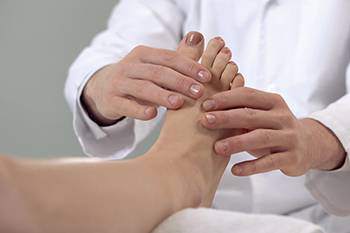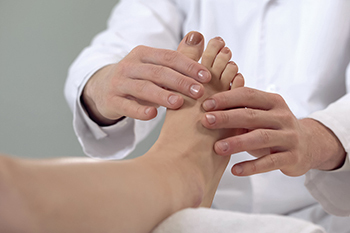
The feet are an interesting and complex part of the body. Each foot is composed of 26 bones and several muscles, ligaments, and tendons that work together to provide mobility and balance to the body. Additionally, the feet carry the weight of the body, and are designed to absorb shock while running and walking. Research has indicated there are three types of foot postures. Humans and animals have the foot structure that is known as plantigrade, and is observed as the entire foot striking the ground while walking. The digitigrade posture is seen in dogs and cats, and is noticed as only the toes are on the ground while walking or running. Animals that run, such as horses, possess the unguligrade posture, and this is seen as a few of the toes touching the ground while running. The human foot has three parts, consisting of the hindfoot, midfoot, and forefoot. Within each foot are bones that are divided into three categories, including tarsus, metatarsus, and phalanges. There are many more parts that make up each foot, and if you would like to know more about how the feet are structured, please confer with a podiatrist.
If you have any concerns about your feet, contact one of our podiatrists from Lewis Wolstein, DPM, P.C. & Associates. Our doctors can provide the care you need to keep you pain-free and on your feet.
Biomechanics in Podiatry
Podiatric biomechanics is a particular sector of specialty podiatry with licensed practitioners who are trained to diagnose and treat conditions affecting the foot, ankle and lower leg. Biomechanics deals with the forces that act against the body, causing an interference with the biological structures. It focuses on the movement of the ankle, the foot and the forces that interact with them.
A History of Biomechanics
- Biomechanics dates back to the BC era in Egypt where evidence of professional foot care has been recorded.
- In 1974, biomechanics gained a higher profile from the studies of Merton Root, who claimed that by changing or controlling the forces between the ankle and the foot, corrections or conditions could be implemented to gain strength and coordination in the area.
Modern technological improvements are based on past theories and therapeutic processes that provide a better understanding of podiatric concepts for biomechanics. Computers can provide accurate information about the forces and patterns of the feet and lower legs.
Understanding biomechanics of the feet can help improve and eliminate pain, stopping further stress to the foot.
If you have any questions please feel free to contact our office located in Co-Op City, NY . We offer the newest diagnostic and treatment technologies for all your foot and ankle needs.









